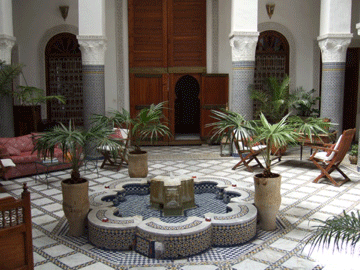
[Interior of the Ryad Mabrouka, a restored guesthouse in Fez medina.]
A trivia question: what may have been the largest city in the known world in 1180 CE? Would you believe Fez (also spelled Fes) in modern day Morocco? Less famous today than Casablanca (thanks to Humphrey Bogart) or Marrakesh, Fes is fascinating for its long history and extraordinary architecture. The Qaraouiyine Mosque, built in 859, boasts the oldest university in the world. The mosque/university library held an estimated 320,000 volumes by 1613 CE. Then there are the palaces of various sultans, the schools, the market and craft buildings, most enclosed within a medina of narrow allies that no cars can penetrate. Here was the a refuge for the 12th century scholar Maimonides, who lived in Fez with his family for five years after being forced to leave Cordoba in Andalusia. Not surprisingly the heritage of Fez makes it a protected World Heritage city of UNESCO. Exactly a week ago, I was visiting Fez as a tourist, an outsider entering a world dedicated to the inside.
This is not a post about the past glory of a Muslim (and Jewish) city dangerously close to the Christian Europe that gave birth to the crusades. That history of that conflict is inscribed silently, as hidden from first view as the majestic mosaics inside the drab buff-dusted buildings that greet the outside world. It is this stark contrast that intrigues me: the outer, walled-in skin of Fez, hardened by centuries, versus the inner jeweled hearts of buildings. Apart from the grandeur on exterior architectural display from opulent monarchs whose tyranny no doubt overcame their humanitarian largesse, the outside was a pragmatic barrier, a kind of hijab that implied the beauty of this city was permitted only to those who were invited inside. Visitors were welcome, a tradition played out today in the steady stream of backpack tourists bobbing along the alley ways, but the beauty of Fez had to be appreciated from the center. The inner courtyards of the mansions began with a fountain, the domes cascaded tiles and delicately painted cedar upwards to a pinnacle: the middle and the zenith defined the essence, as though space should derive meaning only from its center. One lived in rooms looking inward for beauty and walled out from the everyday world of work and politics.
Fez in 2007 is no longer the city of its founder Idris or Maimonides, nor the legion of scholars who diligently copied manuscripts in the university. It has graduated not just to UNESCO heritage status but to the ultimate “third-world” privilege of a tourist haven. The crafts (primarily ceramics, leather, ornate wood carving and metalwork) are souvenirs for outsiders, even modern-day Moroccans who concentrate in cafes of the ville nouvelle. The nice thing about tourism in Fez is that it is not only for leisure-bound Westerners; Moroccans flock here and relive their own past. And perhaps the beauty of this ancient house of memories is that it freezes the future. Here the present is only permitted to look backward. Walk along tal’at kbir, a virtual superhighway in the maze of dead-end darbs, and you share space with donkey carts. Everyone is on foot, no matter whether they are looking to bargain for tourist fare or or locals buying eggs. The future, a frieze of petite taxis and exhaust-fuming busses, is left at the main gates. In Morocco, where the future is rosy mainly for the elites, this makes Fez a much-needed spa for and from the ills of globalized consumer-hungry capitalism.
Should you visit Morocco, there are a number of options for spending the night from the convenience-laden and starred hotels of the ville nouvelle to the humble pensions of the medina. But I heartily recommend a maison d’hôtes just inside the old city itself. This is Ryad Mabrouka, a restored Fez house owned and managed by Michel Trezzy. There are only a few guest rooms and reservations are recommended, especially for the high season, but this splendid and hospitable oasis (with car parking available at the Ain Azlitan gate) is a wonderful place to stay. Book early, bring a book or two to read on the rooftop or in the garden during the lazy afternoons, take a short swim in the pool and enjoy Fez.
Daniel Martin Varisco